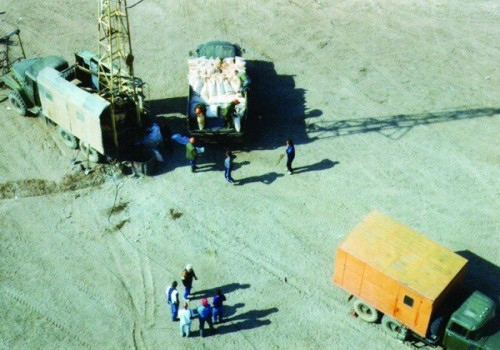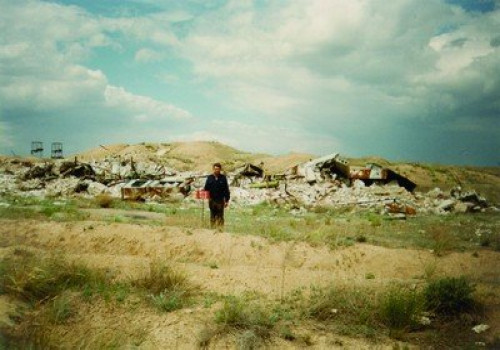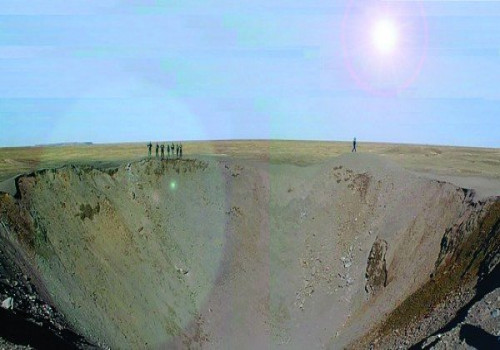Nuclear Testing Infrastructure Elimination. Balapan Boreholes Closure
08 May 2022



30 Projects to the 30th Anniversary of NNC RK!
Project # 5. 1997–1998. Nuclear Testing Infrastructure Elimination. Balapan Boreholes Closure.
Balapan testing site was meant for underground tests. 131 nuclear tests were carried out within 1968-1989 (196 underground nuclear explosions).
12 silo launchers (SL) of intercontinental ballistic missiles (ICBM) SS-18 and 13 unused boreholes remained at Balapan site after STS closure, that were ready for nuclear testing.
Unused boreholes inspection included the following operations: field radiometric measurements at near portal areas of the boreholes, study the current state of boreholes, logging and hydrological researches in the boreholes. Information obtained during studies enabled to develop and recommend methods of each unused borehole sealing and develop measures for safe operations.
The main task of this work was to close and completely seal unused boreholes, and the second task - was to conduct experiments to detonate 25 tons of explosive material in four boreholes that were being destroyed.
In 1997, three boreholes were to be closed by calibration experiments. In 1998, ten testing boreholes were closed with simultaneous conduction of calibration experiments in borehole # 1071‑bis.
20 explosions were carried out at “Balapan” site for 1997-1998. Mass of charges varied from 51.2 to 25040 kg, blasting charge depth – from 0 to 630 m.
Granulotole served as the principal explosive in closure process. Besides, ammonium nitrate explosives – granulite E – were successfully tested in borehole # 1383 on earth surface and at the depth of 190 m.
Considering, that boreholes, for elimination of which explosives were used, are located at the vast territory of “Balapan” site, at that, a significant scope of imaging is possible for tomographic mapping of the velocity characteristics of the test site, all explosions have been recorded by seismic stations of the National Nuclear Center of the Republic of Kazakhstan. A network consisting of 8 temporary 3-component seismic stations was established to register seismic signals at “Balapan” site.
The work resulted in the elimination and sealing of 13 unused test boreholes at “Balapan” site. Industrial explosives, approved for use in the Republic of Kazakhstan, were used for their elimination. The technology for charging and explosion of industrial explosive materials in conditions of hydrostatic pressure up to 6.0 MPa in boreholes of large diameter has been developed and applied for the first time in the world (over 1.0 m).
Seismic waves, caused by explosions to eliminate boreholes, were registered by a network, that was specially created at “Balapan” site of temporary seismic stations, as well as seismic stations and observatories of the National Nuclear Center of the Republic of Kazakhstan.
The final stage of boreholes elimination has been carried out by way of craters backfilling with blasted-out soil, and waste metal location in them, gathered from the boreholes adjacent territories.
Levelling operations were carried out at 100×100 m area after crater backfilling.
In pursuance of the Agreement between the Republic of Kazakhstan and the United States of America on SL ICBM elimination, nuclear accidents consequences liquidation and nuclear weapon proliferation prevention as of December 13, 1993, Agreement between US Department of Defense and the Ministry of Science – Academy of Science of the Republic of Kazakhstan concerning the elimination of nuclear infrastructures dated October 3, 1995 (with amendments as of June 10, 1996) and work on elimination of SL ICBM SS-18, located within the territory of the former field seismic complex, was carried out.
Under implementation of SL elimination operations, RSE NNC RK provided preliminary characterization of working area and final radiological survey, required for elimination project development and assessment of work impact on the environment.
Currently, the territory of SL area can be characterized by soil subsidence due to possible availability of inner cavities. The form of collapse presents circular hollows, channeled by deep fractures of ring and diametral directivity. Sometimes, in the center or on the edge of the hollows there are small (half-meter in diameter) holes, up to 1 m deep. Hollows are of different size, from several meters to several tens of meters in diameter (normally not above 30 m). There is a ring collapse about several meters deep at the place of the undeveloped SL former location, fenced by concrete structures of SL walls.
Radiation situation at the territory of SL location does not present any radiation hazard for the environment and population, radionuclides and metals content in soil are within average values.
Latest news by category:
-
Long-Overdue Recognition
31 December 2025
-
Congratulations on Receiving a Prestigious Award!
31 December 2025
-
Strengthening Transparency Principles
30 December 2025
-
Participation in IAEA International Fusion Research Council Meeting on Controlled Thermonuclear Fusion
25 December 2025